Text
Vienna (Day Two)

Hundertwasserhaus

Vienna Marathon

Vienna University of Economics and Business

Vienna University of Economics and Business

Prater

Prater

Vienna Opera House (Wiener Staatsoper)

Palm Tree House (Palmenhaus (Burggarten))

Burggarten

Austrian National Library (Österreichische Nationalbibliothek)

Sausages for sale at a Easter Market


Cheeeeeeese 😍

Judenplatz Holocaust Memorial/Nameless Library


Ankeruhr (Anchor Clock)
7/4/19
On Sunday we visited Hundertwasserhaus, an apartment building constructed in 1986, and has no straight edges. I also got to see the new campus of the Vienna University of Economics and Business opened in 2013. Throughout the day, we crossed over the route of the official Vienna Marathon. It was impressive to see the number of people running in the hot sun.
Later we visited the Prater, a theme park open 24 hours in a public park. We had coffee outside the Palmenhaus looking out onto the beautiful Burggarten.
After that, we walked towards Judenplatz, the location of the Austrian Holocaust Memorial, otherwise known as the Nameless Library, dedicated to the 65,000 Austrian Jewish people murdered in the Holocaust.
#hundertwasserhaus#vienna marathon#vienna university#prater#vienna opera house#burrgarten#austrian national library#judenplatz holocaust memorial#anchor clock#wien#vienna#österreich#austria#spring#easter break#student exchange
0 notes
Text
Hallo Wien (Vienna)

Johann Strauß Monument

St Stephen’s Cathedral (Stephansdom)

Plague Column (Pestäule)

St Peter’s Church (Peterskirche)

Fiakers (horse-drawn carriages)

Demel

The Hofburg Palace

The Hofburg Palace

Neue Berg wing of the Hofburg Palace

Theseus Temple in the Volksgarten

Palace of Justice (Justizpalast)

Sausage selection at local supermarket.


Leberkäse

Museums Quartier

Library at the University of Vienna
6/4/19
After 3 months of hard work, we finally got our official semester break. We were given two weeks over the Easter period, and I decided to make the most of it with a twelve day trip to Europe. My first stop was the beautiful city of Vienna, where I would stay for four nights. Luckily for me, I had a friend who lived there who was gracious enough to show me around her city. I had flown out of Edinburgh at 6:30 in the morning, so on my first day, we just took it easy and checked out some of the main sites.
Some of the highlights were the Johann Strauß monument, who was a famous Austrian composer. Next we saw St Stephen’s Cathedral (Stephansdom), which is the main Catholic church of Vienna (built in the Romanesque and Gothic styles). Nearby was the Plague Column/Trinity Column (Pestäule). It was constructed to remember those who died in the Great Plague epidemic of 1679. We also went inside St Peter’s Church (Peterskirche), which is a beautiful Baroque church.
While we were walking around the city, we saw a lot of horse drawn carriages (called fiakers). Fiakers were popular in Vienna from 1860-1900 - the carriage drivers were often interesting characters and some performed as singers. These days they are only used by tourists for the price of an arm and a leg (a 20 minute tour costs €55, and 40 minutes costs €80). ��
We stopped for a coffee at Demel, which is a famous pastry shop and chocolaterie, that was established in 1786. An interesting thing I found was that in Austria, you are always served water with coffee. Its so simple, but ingenious. I wish that was done automatically at home.
Next we wandered around the Hofburg Palace complex, where the Hapsburg emperors of the Austro-Hungarian Empire lived (now the Austrian President works here). We also walked through the People’s Garden (Volksgarten) and past the Palace of Justice (Justizpalast), which is the Supreme Court of Austria.
We bought an afternoon snack at a local supermarket - a traditional Austrian snack called leberkäse. Its essentially fritz with a crusty edge, served with sauce and melted cheese in a dinner roll - very yummy.
That night we feasted on a traditional Austrian meal, and for dessert, one of the best cakes I’ve ever had - a home-made sachertorte, which is a chocolate cake, with a tart apricot jam separating the layers.
#johann strauss monument#st stephens cathedral vienna#plague column#fiakers#demel#hofburg palace#volksgarten#austrian sausages#museums quartier vienna#university of vienna#library#sachertorte#wien#vienna#österreich#austria#spring#easter break#student exchange
2 notes
·
View notes
Text
Three Isles Getaway - Day 2


Oban Harbour

The gorgeous Atlantic on the way to Staffa

Fingal’s Cave (Staffa)




Isle of Iona

Isle of Iona

Iona Abbey

A Highland coo & Co

Oban (featuring McCaig’s Tower)
31/3/19
On Sunday we finally made it to the three isles. We had to catch the ferry from Oban to Mull, drive for an hour across Mull, and then take a boat to Staffa and Iona. Luckily, we were blessed with another glorious sunny day.
The bay at Oban was so still in the morning, it created fantastic reflections.
To be honest, there isn’t much to see on Mull until you get to the salt water Loch Scridain. However, along the way there were interesting little quirks, showing how remote and sparsely populated it is, such as rogue sheep. Also, the road we took across the island was more or less a one way road, with alternating pullover bays on each side of the road every ten metres or so, so that you don’t crash into oncoming cars.
The highlight of the day was definitely Staffa. The name Staffa comes from the the Old Norse (Viking) word for pillar island. It was formed by a volcanic eruption - the lava cooled slowly, and cracked into hexagonal clumps. Many of the pillars are flat, so they form natural steps, which is pretty cool. Various sea birds, including puffins, use the cliffs to nest in the Spring and Summer. Unfortunately it was still too early for the puffins, but we saw plenty of other sea birds. The island hasn’t been inhabited since 1800, and I think that's why I loved it so much. Other than some stone ruins, cement steps from the dock, and some necessary, but minimal handrails, the island was unblemished by humans. I had a lovely picnic lunch, looking over the cliffs, into the clear, blue Atlantic.
We went back via the Isle of Iona. Iona was a stark contrast to Staffa, physically and in terms of population. However, I still found it incredibly charming. It is clearly a holiday destination, and personally I’d love to spend a week or two here in the Summer some day.
Iona Abbey was fantastic to see. It was built in 563 AD, and is one of the oldest Christian religious buildings in Western Europe.
Two of the main highlights for me though were the white, sandy beaches, and the island’s abundance of highland coos. This is the closest I’ve ever been to a Highland coo, so that was very exciting for me.
Once we got back to Oban I was exhausted, and sunburnt, of all things! But it was a fantastic weekend, and I definitely intend to visit Staffa and Iona again!
#oban#isle of mull#staffa#isle of iona#atlantic#sunburnt in scotland#highland coo#scotland#student exchange
1 note
·
View note
Text
Three Isles Getaway - Day 1
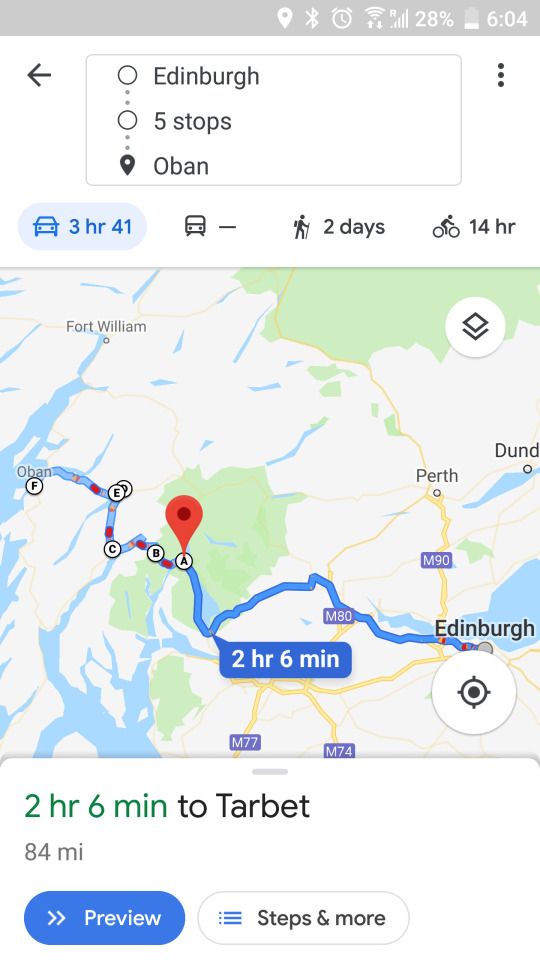
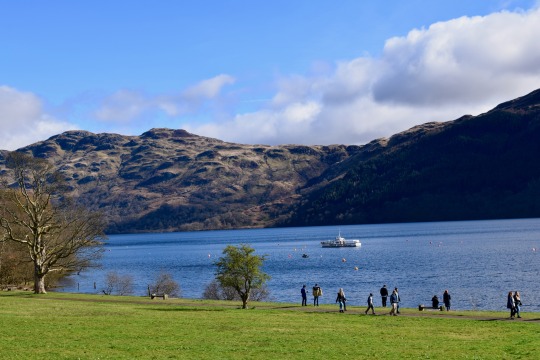
Tarbet, on the banks of Loch Lomond
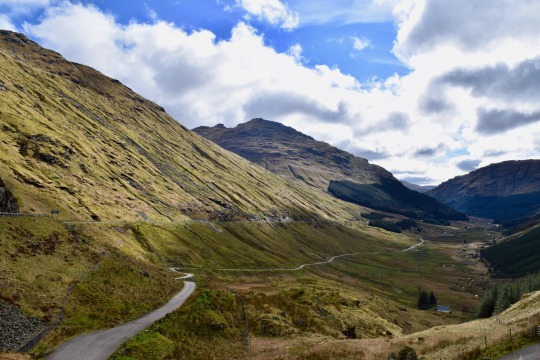
Glencroe
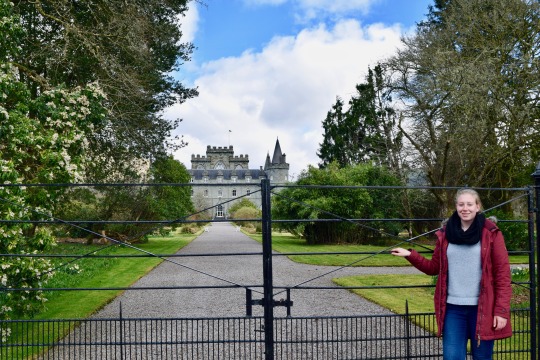
Inveraray Castle
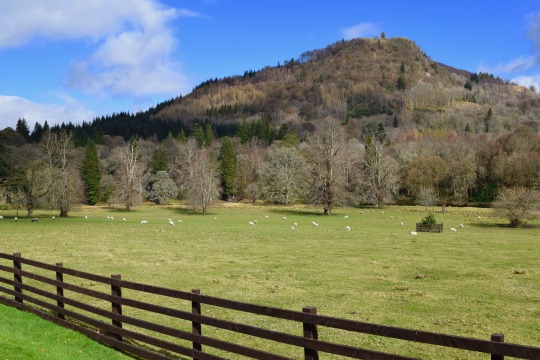
Inveraray
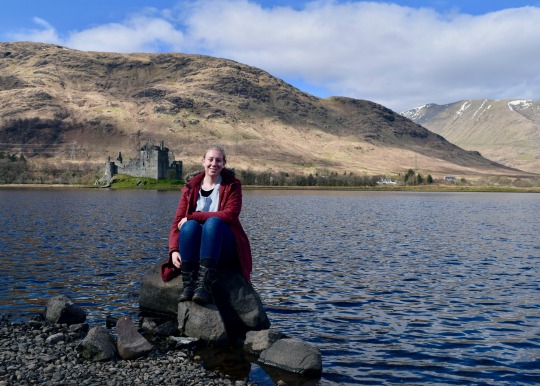
Kilchurn Castle

Loch Awe
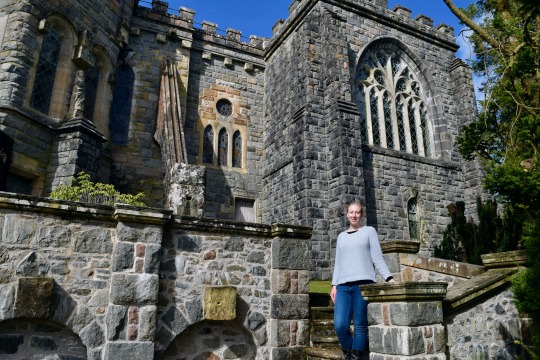
St. Conan’s Kirk
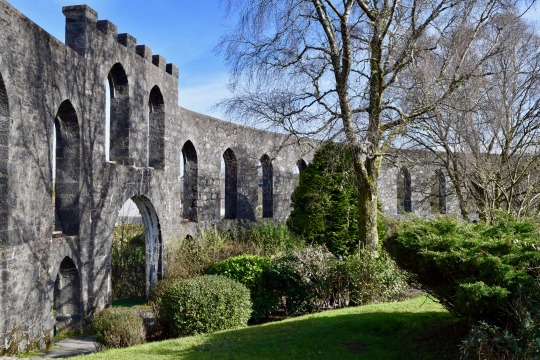
McCaig’s Tower

Oban
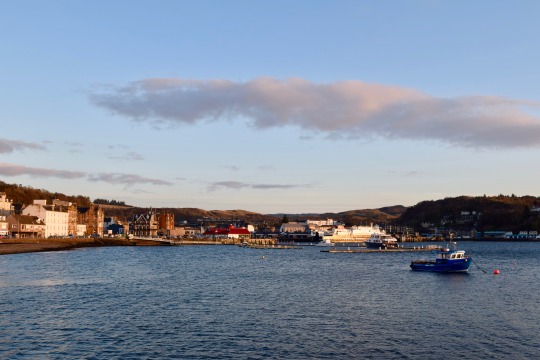
Oban
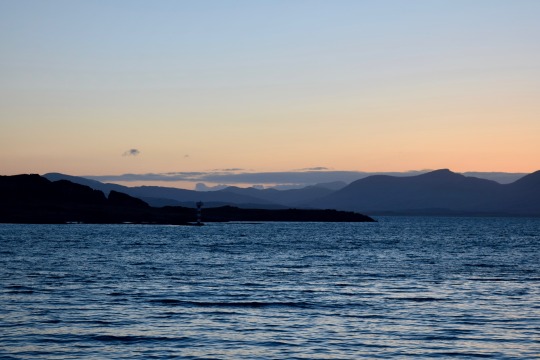
Oban
30/3/19
This weekend I went on a trip to three Scottish isles - the Isle of Mull, Staffa and Iona. It was another early start, leaving at 7:45 in the morning. When I got up on Saturday, I had to keep reminding myself that I had no one to blame for these early Saturday mornings over the past month except myself.
Our first stop was at Tarbet, on the banks of Loch Lomond. The first time I was here was on my trip to Skye. It was raining, and the clouds were drifting low over the mountains. After Tarbet, we drove alongside the lovely Argyll Forest.
Next we briefly stopped at a lookout over Glencroe. Different to Glencoe, Glencroe is a valley famous for the large boulders that are scattered over the mountains.
Later, we spent a bit of time wondering around the village of Inveraray. The highlight of the place is Inveraray Castle, where a Christmas Special of Downton Abbey was filmed. The Castle and the gardens are only open in the late Spring and Summer, so we couldn’t go inside, but it was still beautiful.
In the afternoon, we made two special stops. The first was at a viewpoint for Kilchurn Castle. The Castle sits on the bank of a loch that was so transparent and, thanks to the sun, was the most stunning shade of blue. The second was St. Conan’s Kirk, overlooking the aptly named Loch Awe. Kirk means church in Scottish Gaelic. It is a very interesting church, with many architectural influences. The kirk was built by Walter Douglas Campbell for his mother, since in her old age, she found the journey to the local parish kirk too exhausting. It was built between 1907-1930s approximately. It contains what is believed to be part of a bone of Robert the Bruce, King of Scotland.
Finally, we arrived in Oban, the ‘seafood capital’ of Scotland. The first thing we did was go up the hill, to McCaig’s Tower. Built in a style reminiscent of the Colosseum, it provides an excellent lookout point over the harbour and town. I had some delicious fish and chips looking out over the harbour. It is a very chill place, but with plenty to do. I went to a local gallery, and an ah-mazing chocolate shop!
Later we settled into our hostel, which was actually a converted church, and then walked along the beach to see the sun set over the bay. That night, while some went to check out the live music scene, I stayed in the hostel and played some board games. It was an excellent hostel, and even had an acoustic guitar to play. Luckily there was some people there who were happy to play some tunes for us less talented folk.
#tarbet#glencroe#inveraray castle#kilchurn castle#loch awe#st conan's kirk#mccaig's tower#oban#sunset#fish and chips#seafood capital#harbour#scotland#student exchange
0 notes
Text
Aberdeen


Dunnottar Castle

Dunnottar Castle

Dunnottar Castle

Marischal College

Castlegate

Old Aberdeen

University of Aberdeen (King’s College)

University of Aberdeen (King’s College)

St Machar’s Cathedral

Old Aberdeen

Old Aberdeen

18/3/19 - 24/3/19
On Saturday I went on another IESS trip to Aberdeen and Dunnottar Castle. Aberdeen is only 2 1/2 hours from Edinburgh, so we had much more time to explore than in Inverness.
First we visited Dunnottar Castle. The Castle sits on a granite headland, surrounded on three sides by the North Sea. It was home to significant figures such as William Wallace and Mary Queen of Scots. During the English Civil War, the Scottish Crown Jewels were stored here, safe from the wrath of Cromwell’s army. Also, Dunnottar Castle inspired the castle in the Disney Pixar movie Brave. Due to its location, standing on picturesque granite cliffs contrasting with the gorgeous blue sea, this is the most beautiful castle I have visited in Scotland thus far.
Once we arrived in Aberdeen, we had three hours to kill. Aberdeen is known as the ‘Granite City’, because most of the buildings are made with granite stones (obviously). Here stands the world’s second largest granite building in the world: Marischal College. The building used to be a university, but now houses city council offices. We also visited Castlegate, which is the previous location of Aberdeen Castle, that was destroyed in 1308.
Next we went to a part of the city called Old Aberdeen, which is the location of the University of Aberdeen. I absolutely loved walking through Old Aberdeen, the buildings are so charming, and the stones have so many colours in them. King’s College is the oldest part of the University, and was founded in 1495, making it the third oldest in Scotland, and fifth in the UK. It is certainly much prettier than my classrooms in Edinburgh, but I mainly study in the newer buildings there.
Finally, we went to see St Machar’s Cathedral. The Cathedral was built between 1136-1552, and is said to have one quarter of William Wallace’s body buried here (a medieval hero for Scottish independence). It is also interesting due to the timber ceiling inside the cathedral, which depicts the crests of European sovereigns, ecclesiastical figures and Scottish nobles in the early 16th Century.
I really loved my day in Aberdeen. I definitely think its worth the visit!
#dunnottar castle#brave pixar#marischal college#old aberdeen#university of aberdeen#st machar's cathedral#aberdeen#scotland#student exchange
8 notes
·
View notes
Text
Outlander Tour


Blackness Castle

Blackness Castle

Linlithgow

Linlithgow Palace

Linlithgow Palace

Statue of Mary Queen of Scots - Linlithgow Palace

Linlithgow

Duone Castle

Stirling Castle

Culross

Culross

Culross

Culross

Culross

Culross

17/3/19
On Sunday I went on a tour with Rabbie’s, of various sites where the show Outlander was filmed. It was a day long tour, but a LOT closer to Edinburgh than Inverness. Also, although it was windy, we were blessed with warm sunshine, which was in stark contrast to the day before. Interestingly though, while we were in the sun, we could see snowcapped mountains nearby, which no doubt received the snow we drove through on Saturday.
Our first major stop was Blackness Castle. It is sometimes referred to as the ‘ship that never sailed’, because it is somewhat shaped like a boat. This castle took the place of Fort William in the show. I visited the real Fort William in February, but these days nothing is left of the real fort but the base. Inside the castle, there was also a Lego exhibition of various cities around the world, which was cool to see.
Next we went to Linlithgow Palace, the place where Mary Queen of Scots, and her father, James V, were born. The Palace was destroyed by a fire in 1746, but you can still explore many of the rooms. The Palace represented Wentworth Prison in Outlander, and despite the dark scenes filmed here, it was a lovely place to visit. The Palace soars over Loch Linlithgow and is surrounded by gorgeous parklands.
In the afternoon, we went to visit Duone Castle, pronounced ‘doon’ (which means ancient stronghold). The Castle was the home of the Duke of Albany (Robert Stewart) between 1388-1420, who is known as the ‘uncrowned king of Scotland’. The castle was also used to film the Castle Leoch scenes in Outlander, and a few scenes from Monty Python and the Holy Grail, including the insulting Frenchman, Swamp Castle and Camelot scenes. We had an audio guide narrated by Terry Jones, the film’s co-director and co-star, which was fantastic. It was also used as Winterfell in the pilot of Game of Thrones.
We drove past Stirling Castle a couple of times. Stirling Castle was the most important castle in Scotland for a very long time due to its strategic geographic position. There is a common quote: ‘he who holds Stirling, holds Scotland.’ You may also know it from the movie Braveheart (which is VERY loosely based on a major battle here). We didn’t get to go inside, but I might try another time.
Finally, we visited the historic village of Culross (pronounced ‘coo-ross’). Many of the 16th Century buildings have been preserved. It poses as the village of Cranesmuir in Outlander, and is also the location of Claire’s herb garden. Its such a picturesque little village, and I loved strolling along the cobbled lanes.
Overall, it was a fantastic day, and I would definitely recommend to any Outlander fans, or anyone interested in castles and exploring the Scottish lowlands.
#outlander tour#blackness castle#linlithgow palace#duone castle#monty python and the holy grail#game of thrones#stirling castle#braveheart#culross#scotland#student exchange
71 notes
·
View notes
Text
Ahoy Nessie


Mountain Café in Aviemore

Snow in Aviemore

Snow in Cairngorms National Park

Loch Ness

Urquhart Castle




Inverness Riverfront - John Small (Inside the Inverness Museum and Art Gallery)

River Ness

16/3/19
Today I took another trip with the IESS, to Loch Ness and Inverness. It's about 4 hours drive from Edinburgh so we had to leave very early to have enough time to look around - about 7:30am! I had to walk through pretty strong sleet to get to the bus, and this was the first time I had seen anything resembling snow in weeks. I was actually shocked to see snow in the middle of March - Winter here is much longer than in Australia!
The sleet continued out of Edinburgh, but once we reached Cairngorms National Park, there was snow everywhere. With all the pine tree plantations it looked a lot like Christmas - it was beautiful! We stopped after 3 hours in a place called Aviemore. The town is known for its proximity to forests, lochs and a ski resort. It was a lovely place to stretch the legs, and walk around in the snow whilst cradling a delicious coffee 😋
The landscape looked completely different from about ten minutes out of Inverness, and we arrived at Loch Ness just before 12. There was no snow at all, but it was raining a lot. Our cruise was supposed to leave at 12 sharp, so we all had to run down to the boat, which definitely woke everyone up! Our cruise of the Loch on the Jacobite Warrior lasted an hour. It was nice, but raining and windy, so visibility wasn't great, and it was a bit uncomfortable to be outside, but that's Scotland for ya.
I didn't see anything out of the ordinary, but I did learn some stuff. I knew it was deep, but I didn't know that there are basically no shallow parts of the loch. Essentially, the loch sits between two hills that keep going down underneath the water, so it doesn't really flatten out in between. This means that there are very few places in the loch where a boat can drop it's anchor. Also, the loch is very good at preserving things that fall in it. They were able to recover a plane from WWII in almost perfect condition, that had been in the loch for 45 years. This is due to the peat that washes into the water from the mountains, that makes the water very murky, meaning that light doesn't penetrate. Due to the lack of light, the temperature is also consistent, and makes the water have high alkaline levels, which is good for preservation. The peat is also the reason that the water of Loch Ness is never blue, even when the sun is out.
After our cruise, we went to Inverness. We spent two hours here, and got the chance to look inside St Andrews Cathedral, the local museum and the Victorian Market. It had been raining a lot, and it was pretty constant while we were there, so the River Ness was very swollen and flowing very rapidly, but was quite eery how silently it flowed.
I don’t think I’d go back to either of these places, but I played the ultimate tourist and can now say I’ve seen Loch Ness.
2 notes
·
View notes
Text
Its Warming Up, Slightly

4/3/19 - 15/3/19
I spent the majority of these two weeks catching up on uni work. However, in my spare time, I went for lots of walks around the Meadows. The daffodils were starting to come out now - its so weird to see them in March, instead of August.
On Saturday the 9th I went to watch my first rugby game (only in a pub). It was a pretty big game, Scotland v Wales in a rugby union competition called the Six Nations Championship. It was an electric atmosphere, though unfortunately for most fans, Wales won the match.
On the 13th, they also had alpacas in George Square, as part of a de-stressing initiative. I didn’t have time to pat them, because there was a crazy long line, but they were still adorable to watch.
1 note
·
View note
Text
Isle of Skye - Day 2


Sligachan Bridge and Cuillins


Old Man of Storr - Trotternish Peninsula


The Old Man of Storr (the pinnacle on the right)


Mealt Fall

Kilt Rock and Sound of Raasay

Lealt Gorge

That awkward squinting through the rain look

Sheep will never waste some tasty grass, no matter how obscure the location

Sound of Raasay

Portree



3/3/19
On Sunday we set out to explore Skye.
First we visited Sligachan Bridge and the Cuillins. There’s a legend that if you dip your face in the river for 7 seconds, you will be eternally young and beautiful. I didn't do this myself, since the water was freezing, but lots of others did. It was really beautiful there - the river was mesmerising, and seemed to have a life of its own.
Next we went for a hike to see the Old Man of Storr. It was a short hike, only 20 minutes, but very steep! From here we could see the Old Man of Storr, emerging from heavy cloud, on one side, and a spectacular view of Loch Leathan and the Sound of Raasay. There are various folklore stories about the rock formation. One interesting story is that they are the fingers of a giant, buried under the earth. Another one is that a couple used to walk along the peninsula everyday, while mythical fairies watched them. Eventually, the wife was too old to reach the top, and so the fairies offered the husband a wish. He wished that he and his wife could always be together, however, the fairies tricked him, and turned them both to stone, doomed to stand together forever. It was very windy here, with a heavy dose of rain and shine - a pattern that would continue throughout the day.
Later we visited Kilt Rock, the Sound of Raasay, and Mealt Fall. Kilt Rock is an interesting cliff-face, formed by volcanic activity. It is supposed to look like a kilt, but personally I don’t see it. The waterfall is also interesting, because it is one of few that falls directly into the ocean. The Sound of Raasay is a saltwater inlet, separating Skye (as the mainland in this case), from the Isle of Raasay. Sound is the Gaelic word for this specific type of body of water. This site was also our most northern stop on Skye.
Next we went to Lealt Gorge and Lealt Falls. This was my favourite spot on Skye, looking out over the Sound. I feel like this place symbolises all the best parts of Skye. From rugged cliffs, scattered with local creatures, to the deep blue sea. It was a truly blowing a gale, and it was the first time I ever thought the wind would pick me up and carry me away. Skye is a natural wonder, and it is everything I hoped Scotland would be.
Finally, we had lunch in Portree. It is the largest town on Skye and we enjoyed some classic fish and chips there. One thing we saw a lot of, being a fishing village, were seagulls. We see them in Edinburgh too. I’m always surprised at how big they are - they are about 1/3 bigger than Australian seagulls, and a bit prettier I think.
It was an exhausting weekend, but definitely worth it!
#sligachan bridge#old man of storr#kilt rock#sound of raasay#mealt fall#lealt gorge#portree#isle of skye#scotland#student exchange
1 note
·
View note
Text
Isle of Skye - Day 1


Luss

Luss

Loch Tulla and Caledonian Village

Three Sisters of Glencoe


Tired Aussie tourist

Eilean Donan Castle

Skye Bridge

Broadford
2/3/19
We left Edinburgh bright and early at 7:45am. I was excited on the inside, but its hard to show it on the outside at such an ungodly hour, especially after very little sleep!
Our first stop was at the village of Luss, which was about 2 hours from Edinburgh. Luss is on the shore of Loch Lomond, and is further north and on the opposite side to Balloch, which is the other village I visited on Loch Lomond a few weeks before. Luss used to be called Clachan Dubh in Gaelic, which means Dark Village. The town is known to have inspired a song called The Bonnie Bonnie Banks of Loch Lomond. The song is about two friends from Luss, who were Jacobite rebels captured by the British. One friend was executed in London while the other was released and sent home to warn others of the consequences of rebelling. I like the version of the song by Runrig - it turns a classic folk song into an awesome rock anthem.
Next we stopped at a viewpoint over Loch Tulla and the Caledonian Forest. The Forest used to cover a significant area of Scotland. The loch is a freshwater loch, where salmon are bred.
Then we visited the Three Sisters of Glencoe. It was vastly different from the last time I was here - the weather was much nicer this time! We got the chance to walk around and explore a little, which was great. It was very muddy and windy, but absolutely stunning all the same - the beauty is very difficult to capture on camera. The Three Sisters each have their own Gaelic name: Beinn Fhada (dark ridge), Gearr Aonach (short ridge), Aonach Dubh (high ridge).
We stopped in Fort William for lunch. I went to the Wildcat Café again, and had a mouthwatering veggie lasagne. There was less snow on the mountain tops than last time, and the daffodils were out now too.
In the afternoon, we took an incredibly scenic route to Skye. The further north we went, the more rugged the landscape became - it was stunning. As it was raining quite a bit, we also got to see lots of waterfalls along the way that only added to the beauty. We also saw quite a few sheep, and some ‘highland coos’ (highland cows), though they looked a bit depressed in the rain.
We stopped at Eilean Donan Castle, which is the most commonly photographed castle in Scotland. Because of the rain, I couldn’t get a great photo of it, but it was nice all the same.
By the late afternoon, we made it to the Isle of Skye. It gets dark there very early, so we weren't able to see much of the island yet, and instead we settled into our accommodation for the night in Broadford.
0 notes
Text
See Ya York

Fog over the River Ouse

Brew & Brownie



York City Walls

Alice in Wonderland - Alice sculpture

York Minster

The Perky Peacock

Ceilidh

25/2/19 - 1/3/19
I was due to leave York around midday, so I thought I’d take one last leisurely stroll around this historic city. It was very foggy over the River Ouse that morning, and it was so peaceful. I had breakfast at a place called Brew & Brownie, which was recommended to me from someone at the hostel. I’m so glad I want there, the pancakes were ah-mazing! While I was there I also got chatting to a local from York. She said that she went on exchange to Canada in her youth, and she thinks it is one of the best things someone can do. I completely agree. She said that her sister lives in Adelaide now, after falling in love with the tour guide while she visited Australia. I think that's such a nice story. She was drinking a Bundaberg Ginger Beer, and I pointed out that it was Australian, and also my favourite ginger beer. She was lovely enough to buy me one. She said that when she was in Japan, a local treated her to something, and she’s always wanted to pass it on. Its experiences like these that make travelling alone, rather than with a guided tour, truly unique - you actually get to interact with locals.
Next I took a walk along the city walls and had one final look at York Minster, towering over the city in all its glory and grace.
That night, back in Edinburgh, I attended a ceilidh hosted by the IESS in the Teviot. It was so much fun, especially with the live ceilidh band. We did some of the same dances as the Scottish dancing earlier in the semester, such as the Flying Scotsman, Virginia Reel and Waves of Tory.
#river ouse#brew & brownie#pancakes#york city walls#alice in wonderland#york minster#the perky peacock#york#england#ceilidh#edinburgh#scotland
0 notes
Text
Jorvik Viking Festival Pt.2





The Shambles Market

Traditional lolly shop on The Shambles


Famous place for afternoon tea

Christmas store

24/2/19
After I visited the Jorvik Viking Centre I walked around the city for a little while.
A highlight was accidentally finding the Shambles Market, which only runs on Sundays. I bought a beautiful print from an artist from the area.
#jorvik viking festival#the shambles market#confectionary#christmas decorations#jorvik#york#england#student exchange
1 note
·
View note
Text
Jorvik Viking Festival Pt.1

Stained Glass Centre - 10th Century Traders Markets

Stained Glass Centre - 10th Century Traders Markets

Partisan Café



Merchant Adventurer’s Hall - 10th Century Traders Markets

Merchant Adventurer’s Hall - 10th Century Traders Markets

Merchant Adventurer’s Hall - 10th Century Traders Markets

Merchant Adventurer’s Hall - 10th Century Traders Markets

Merchant Adventurer’s Hall - 10th Century Traders Markets

Merchant Adventurer’s Hall - 10th Century Traders Markets

Jorvik Viking Centre
24/2/19
On Sunday I decided to attend some of the events around the city for the annual Jorvik Viking Festival. The modern name of York actually comes from the viking name for the city, which was Jorvik. The festival was from 20-27 February this year, and so there were people walking around in viking costumes (adults and kids), and fake weapons most of the time I was staying in York. It was kinda cool how much people got into it. I think it was the half term break for the kids, so there were lots of families out and about, having a great time.
Today I had planned to go to the 10th Century Traders Markets, held in two venues, and the Jorvik Viking Centre.
In the morning I went to the first market, in the Stained Glass Centre. The building was very rustic and beautiful. I didn’t buy anything, since I couldn’t see the use for a viking horn etc., but I did have my first sip of mead. It was so different to what I thought it would be - I had no idea it was made from honey! It was quite nice actually, but I don't think it will be my drink of choice anytime soon.
Later I went for a walk up the street in search of a mid-morning coffee. Little did I know when I came across Partisan that it is one of the busiest Sunday brunch places in York. Despite that, it was really lovely, and I thoroughly enjoyed the chance to sit outside in the sun with my latte and a scone. One thing I’ve learned now is that when you ask for cream with a scone in the UK, they always serve Cornish Clotted Cream. Personally I don’t think its that different from what we get in Australia, maybe just a little thicker, but its tasty nonetheless.
Next I went to the Merchant Adventurer’s Hall. The tour guide showed us this on Friday, and he said its a popular wedding venue, and costs a pretty penny to book. I can see why. Its a beautiful building, with an exposed timber frame, that was built between 1357-1368. The garden outside the Hall is also very charming and peaceful. Inside, I bought some beautiful pottery. Even though the pots are small, they are heavy - but I couldn’t resist. I only hope they survive the trip home!
In the afternoon I went to the Jorvik Viking Centre. I decided to book a time to go when I arrived Tuesday night, and to my surprise, all the sessions were booked out until Sunday. Luckily I was able to get in one of the five spots not yet sold out. I doubt it would normally be this busy, but without booking, people had to wait in line up to an hour just to get in, due to the Festival of course. It was a really interesting experience. First they took us on this ‘rollercoaster’ thing, where we sat in a carriage and travelled around a reconstructed viking street. The Centre is actually located above an old street where lots of viking artefacts were concentrated, so the archeologists used this as a basis to reconstruct the street for visitors. On the ride, you could see, hear, and smell what it would have been like back in the 900s AD. The smelling part was pretty foul to be honest. They also had lots of creepy, lifelike robots scattered along the way doing things such as carving wood and antlers and dyeing linen. After the ride they had more of a traditional museum set up, showing the artefacts they found there. It was an entertaining place to visit.
#jorvik viking festival#mead#partisan york#clotted cream#vikings#jorvik#york#england#student exchange
0 notes
Text
Richmond

Holy Trinity Rectory

York Train Station

Richmond


Richmond Market Square

Richmond Castle Garden

Richmond Castle

“The Station” - local art and produce hub


Easby Abbey


The Gatehouse to Easby Abbey

River Swale

River Swale Waterfalls
23/2/19
On Saturday I ventured into Northern Yorkshire again, to a market town called Richmond. It was a bit of an adventure, since I had to take a train to Darlington and then a bus to Richmond. I love travelling via train in the UK, its so easy and cheap for students.
First I had a walk around the market place. Outside, they were holding their weekly market, selling mainly produce, and inside the Market Hall, there was a variety of stalls selling crafts and books.
Next I checked out Richmond Castle. The name Richmond comes from the French riche-mont, which means “strong hill”. The Castle was primarily built between 1070-1160 by the cousin of William the Conqueror, to secure the French rule against the defeated Anglo-Saxon nobles. Various significant people held the Honours of Richmond. For example, before they each became king, Richard III and Henry VII held the title of Earl of Richmond. I spent quite a while exploring the Castle. Most of the buildings are now in ruins, except the keep (tower), but it was really interesting to look around. It was a glorious day, and many families were enjoying lunch on the many picnic tables on the green.
I went for lunch at a cafe in the Market Place. Since the sun was out, and it was relatively warm (14℃) I decided to get Yorkshire lemon curd ice cream for dessert. It was delicious!
After lunch I made my way to Easby Abbey. The Abbey lies out of town, and to get there I walked along a beautiful wooded path, following the River Swale. On the way, I happened upon a place called The Station. This arts and produce centre and cinema is located in an old Victorian Railway Station. There were so many people (and lots of dogs), and it had a real community atmosphere - I loved it!
Easby Abbey (also known as St Agatha’s Abbey), was built in 1151. Although it is in ruins, it was clearly an impressive structure in its prime. The Abbey was destroyed during the reign of Henry VIII.
Finally, I walked back along the river to see the River Swale Waterfalls.
It was a really nice day, and I loved the town so much. I could imagine myself living there one day.
#richmond castle#ice cream in winter#easby abbey#river swale#yorkshire dales#yorkshire#england#student exchange
1 note
·
View note
Text
York Minster












22/2/19
To end the day, I went for a tour of York Minster. The Cathedral was built between 627-1472, and features flying buttresses, like Notre-Dame in Paris. The inside is exquisite, however the real highlight for me was the view from the top of one of the towers. It was 275 steps up narrow, spiral staircases, but it was all worth it for the breathtaking views of the city.
9 notes
·
View notes
Text
York

The Holy Trinity Rectory, opposite my hostel.

Lendal Bridge

The Perky Peacock

The Perky Peacock

The City Walls

View from the City Walls - York Minster



The Shambles


Clifford’s Tower, surrounded by daffodils

22/2/19
After two days out in the countryside, I devoted Friday to exploring the city of York. For breakfast, I came across this gorgeous little cafe called The Perky Peacock, which is inside an old toll booth next to Lendal Bridge. I think that leasing these buildings to businesses is such a cool way for the City to subsidise their maintenance. Lendal Bridge itself is beautiful - built in 1863, and decorated with the white rose of York, the crossed keys of the Diocese of York, the lions of England and the York Coat of Arms. The cafe was also really nice, and I had a delicious coffee, and porridge with banana chips and honey, while overlooking the River Ouse.
Next I went on a 3 hour, free walking tour with White Rose York. The guide was very informative and took us to York Minster, the City Walls, the Shambles and Cliffords Tower. I thoroughly enjoyed this tour and learnt lots of things about York’s history, including the Roman and Viking influence, and that the humble KitKat was invented here in 1935 and was then known as Rowntree’s Chocolate Crisp.
The guide was an interesting character. He had actually performed in the Adelaide Fringe as a stand up comedian before, but he is also very passionate about history, which definitely showed. One of the most interesting things he talked about was that Richard III (also known as the uncle of the Princes in the Tower), is considered much more favourably in York than in other parts of England. This is especially compared to his Tudor successor, Henry VII. He believes that Richard III was treated unfairly after his death, and that his reputation was butchered by the Tudors in order to strengthen Henry VII’s reign. I found this perspective very interesting, and it prompted me to visit the museums dedicated to the two kings later that day.
The Shambles was also a highlight of the tour. The Shambles used to be the main butchers street. The buildings hang over the street, which would have provided shade and kept the meat cool while it was out on display. Some of the buildings here date back to the 1300s. These days however, it is known to have supposedly inspired Diagon Alley in Harry Potter.
At the end of the tour I went up Clifford’s Tower, which is the last remaining structure of York Castle. The original timber tower was built by William the Conqueror, but it burnt down during the horrifying Mass Suicide and Murder of 1190. At the time there were huge riots by Christians against the Jewish population. 150 Jewish people sought refuge in the tower, however, a furious mob was determined to capture them. At the hands of the mob, they faced either a forced conversion to Christianity, which they believed would condemn their souls to eternal damnation, or death. So instead, they decided to commit a mass murder and suicide, and set the Tower on fire. The Tower was replaced with wood in 1194, and in stone in the late 13th century. The view of the city, and York Minster in particular, was beautiful.
#the perky peacock#cafe#white rose york#york city walls#kitkat#richard iii#the shambles#diagon alley#harry potter#clifford's tower#york#england#student exchange
8 notes
·
View notes
Text
Ye Olde Starre Inn



21/2/19
On Thursday night, I went for dinner in supposedly the oldest pub in York - it is said to have been serving since 1644.
The food was good but I probably enjoyed the atmosphere more.
0 notes